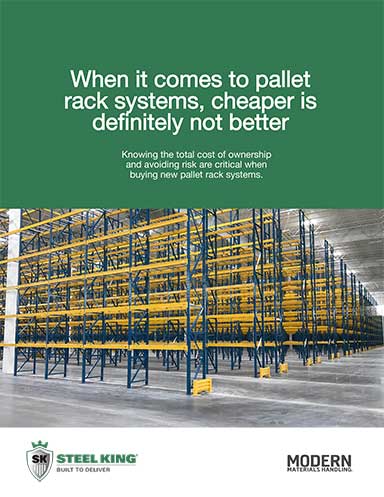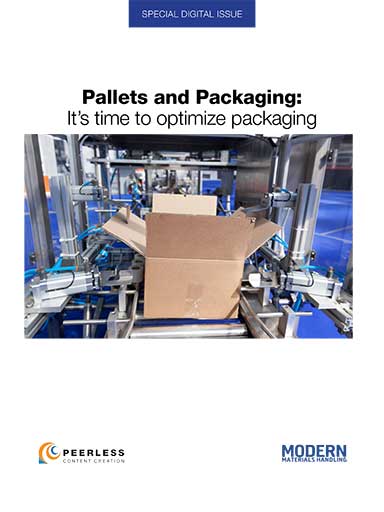The story in pallets
No longer to be taken for granted, pallets of all types are central to steady performance gains not just across the supply chain but inside facilities.
So, you’re going to lunch today with your team, and you want to be ready. You know this group, and somebody is sure to bring up the subject of pallets. What are you going to tell them?
Don’t worry. Modern has your back.
Three words are sure to get you and the conversation going: sustainability, automation and innovation. Better yet, all three are actually interconnected.
Who would have thought? But they are. So, stay with us here. It’s actually quite an interesting story with a host of key players.
At this point, it’s actually more than a little off the mark to be dismissive of pallets. More is expected of them than ever and they’re rising to the challenge. Pallets may not be glamorous, but…
No longer is a pallet just a pallet. Furthermore, pallets of all types are receiving a dose of attention to extend their time of usefulness, their performance during that time and how they are disposed of when it’s all over.
The big picture
To begin, the number of pallets alone is massive.
Wood accounts for roughly 90% of all the pallets in use today, which is generally estimated to be roughly 2 billion in the United States and 5 billion worldwide. Plastic pallets are the strongly dominant alternative to wood, although metal and cardboard pallets are also in the count.
Now, those numbers are the total number of pallets in use. They range from unit-load shipments across the supply chain to captive pallets dedicated to automated and manual systems at a single location. All pallets transport an estimated 93% of all products moving through the supply chain.
There is no known breakout of the split between those two uses. And the number of trips those 2 billion pallets make collectively in a year is another unknown.
How many trips can that pallet make?
That said, there is a steadily increasing emphasis on maximizing the number of trips any single pallet makes in its lifetime of use. In fact, there’s quite a bit of effort being expended here. Just ask Alison Zitzke, senior product manager at ORBIS.
She points to plastic pallet testing done by the Virginia Tech Center for Packaging and Unit Load Design. ORBIS tested its 40 x 48 Odyssey pallet, says Zitzke. It survived 400 cycles, or trips within the supply chain, without failure. That’s 36 times the life span of a same sized whitewood stringer, which lasted 11 cycles in the Virginia Tech’s FasTrack lifecycle analysis.
As Ben Remmey points out, a wooden pallet generally maxes out at about 10 trips. Remmey is president of wood pallet maker Remmey-The Pallet Company.
“But, it’s not just a matter of building the right pallets for specific loads and getting the maximum life out of them,” says Remmey. “It’s also a matter of proper disposal of those pallets regardless of the number of trips each makes.”
About 95% of wood pallets are converted to reusable materials (new pallets to mulch), says a report in 2018 from Virginia Tech, the USDA Forest Service and the National Wooden Pallet Association (NWPCA).
Earlier this year, the survey was replicated and expanded. Results are expected to be released later this year. There are some expectations that an even higher percentage of wood pallets are now recovered. In other words, they don’t go into landfills.
On the plastic side, Zitzke says final disposition is important, too.
She estimates that at least half of all companies she deals with consider recyclability of plastic pallets to be a core product characteristic. “More people want to buy from companies that make sustainability and recyclability a top priority.”
There are not, however, any industry figures for plastic that are comparable to those for final disposition of wood pallets.
Zitzke continues to explain that the level of recycled materials in a plastic pallet typically ranges from 20% to 100%. That process, she adds, is becoming increasingly sophisticated as ORBIS better understands and is able to deliver specific pallet specifications required for specific applications.

Meanwhile, Zitzke says the number of pallets with recycled material continues to grow as a percentage of all plastic pallets produced. That growth could be as high as 10% annually.
ORBIS also offers companies the ability to do Packaging Life-Cycle Assessments, to compare reusable and single-use packaging, ORBIS applies data-driven analysis to help customers reduce their overall environmental impact in terms of greenhouse gas emissions, water, solid waste and energy usage.
Behind the scenes sustainability
When looking at pallets, a couple of other story lines are important behind the day-to-day use of pallets. One is focused on pallet pools and the other on repair and reuse of pallets.
The largest single pallet pool operator in the world is CHEP, which is in nearly 60 countries. In a pallet pool, the platforms, typically, are part of a continuous supply loop or network between a series of companies shipping goods.
As Jason Adlam, vice president new business development for CHEP U.S., explains, the company manages pallet movement day in and day out.
One of the company’s measures of sustainability is to reduce the number of empty miles that over-the-road trucks drive.
Adlam says in the company’s last fiscal year, CHEP’s North American collaborative transportation solution eliminated 3.5 million empty miles from networks. In turn, that averted more than 10 million pounds of unnecessary carbon dioxide emissions.
In addition, says Adlam, use of CHEP pooled pallets rather than single-use pallets saved 734 million pounds of carbon dioxide in 2023. CHEP also offers an online calculator to determine the environmental savings of pallet pools compared to single-use pallets.
Those savings calculations, says Adlam, are based on ISO 14040-compliant lifecycle analyses reviewed by independent experts.
Meanwhile, Zach Gilbert, chief commercial officer at PLA, is focused on the repair, recycling and reuse of wooden pallets. He says there has never been a stronger emphasis on high quality pallets.
“Supply chains in general require pallets that are both structurally strong and meet specs more precisely,” says Gilbert.
Automation’s influence
Gilbert continues to say automated systems are among the most demanding applications for pallets today. And it’s true for both wood and plastic, others add.
While sustainability might be the headliner in pallet development and use, automation is right there, making its case for tighter spec pallets.
As you already suspect, wood pallets still dominate in automated systems of all types. However, plastic is very much in the hunt, says Zitzke.
One reason for interest in plastic is its ability to be molded to very precise tolerances. She explains more precise tolerances ensure a pallet (of any type, actually) has less opportunity to get hung up an automated system transfer. The goal is for the pallet to move as easily as possible without any snags in an automated system.

Another strong attribute of a plastic pallet is its deck design and surface, says Zitzke. Some would call it the coefficient of friction. Permanent molded-in frictional elements minimize load shifting.
As Gilbert points out, “automated systems require a superior pallet. This certainly doesn’t rule out wood, it just requires a higher quality pallet within tighter spec.”
That need has not been lost on Remmey, either. He is currently looking at an end-of-line, AI-enabled technology that automatically checks pallet components and the finished pallet’s specs against pre-set specs.
Although the technology is still relatively new to the industry, Remmey says artificial intelligence is part of the magic behind getting this right. “Especially for automated systems, we need to produce a quantitatively graded pallet that hits all the specs to the same standard every time,” he adds.
The power of innovation
Clearly, innovation is a strong determiner today of future success of pallets in the future. As was said earlier, no longer is a pallet just a pallet. Specialized applications require not just specific designs but a new cost performance profile.
Remmey tells the story of a $3 billion company that supplies the automotive industry. It installed an automated storage and retrieval system (AS/RS), without giving the pallets in it much thought. Remmey was called in to redesign the pallet when issues were discovered.
“The footprint of the pallet remained the same, but we added a stringer and changed the locations of the stringers,” explains Remmey. Board thickness was also reduced slightly.
“The redesigned pallet is now much more nimble in the AS/RS due to the redesign. But we also reduced the amount of lumber in the pallet by 8.5% and total cost by 5%,” says Remmey.
Over at CHEP, Adlam calls this process ideation. “Optimizing pallet performance and total design value is all about partnerships that collaborate to explore different concepts,” Adlam says.
Those concepts range from pallet testing and packaging design innovation to identifying new efficiencies in the pallet pool network. In all cases, the objective is to maximize performance of the pallet, reduce time to cycle through the network and trim costs, explains Adlam.
CHEP even has a 15,000-square-foot, ISTA-certified innovation center in Orlando to house these efforts. You could call it the Shake, Rattle and Drop center. Pallet designs undergo rigorous testing, says Adlam, to ensure goods arrive shelf-ready for consumer consumption.













